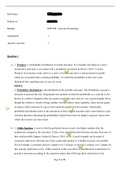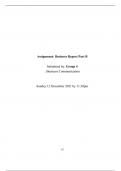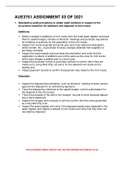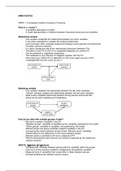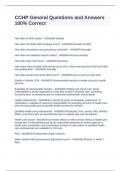IOP2605
ASSIGNMENT 3
YEAR 2024;
SEMESTER 2
CONTACT +27611279778 OR EMAIL;
, QUESTION 1
1.1 Identify factors that distinguish a learning organisation in the context of higher
education from a learning organisation in other types of businesses. Furthermore, in
your own words, give two reasons why universities become learning organisations.
(10)
The notion that a learning organization is limited to higher education institutions is among the
most widespread misconceptions about them. While educational institutions may receive
most of the attention, any establishment that promotes learning-based growth and plans to
keep doing so can be considered a learning organization. But to ignore colleges,
universities, and professional schools as major players in the educational field would be
negligent. An institution of higher learning's primary purpose is to create and support the
knowledge that instructors impart to their students. Although associations of teaching make
up the majority of a learning organization's characteristics, learning organizations are not
inherently tied to locations of instruction.
A group of individuals who "continually expand their capacity to create the results they truly
desire" is what learning organizations, according to one of the most well-known researchers
on the subject, Peter Senge, define as [6]. Its function is to empower people not only inside
the building but also outside of it in the neighborhood and in society at large.
1.2 In your own words, describe the difference between human capacity and human
capital. Use a table – marks will be deducted for not using a table. (4)
Both the term "human resource" and the term "human capital" refer to the present or
potential human skills, talents, and abilities that are vital to the success of any organization.
Both ideas are commonly misinterpreted and incorrectly combined. What is meant by human
resources and what is meant by human "capital" differs in a few small but important ways.
The article explores the similarities and differences between these terms, giving a thorough
explanation of each and highlighting their subtle but important differences. Human capital is
an essential component of production, and hiring individuals with the right training,
education, experience, and skills can increase productivity, profitability, and efficiency.
1.3 Identify the two categories of teams and in your own words, describe the types of
teams under each category. (7)
[21]
QUESTION 2
2.1 In your own words, discuss the various frameworks that assist in the development of
the required skills in the era of rapid technological change and globalisation. (12)
Recent decades have seen a dramatically accelerating pace in the development and
adoption of new technologies, even though various gaps persist in terms of adoption
in different parts of the world, especially in the least developed countries. This rapid
technological change is affecting almost every area of the economy, society and
culture.
Rapid technological change involves, among others, technologies like big data, the
Internet of things, machine learning, artificial intelligence, robotics, 3D printing,
biotechnology, nanotechnology, renewable energy technologies, and satellite and
drone technologies. These represent a significant opportunity to achieve the 2030
Agenda and the Sustainable Development goals.
At the same time, rapid technological change poses new challenges for
policymaking. It can outpace the capacity of Governments and society to adapt to
the changes that new technologies bring about, as they can affect labour markets,
perpetuate inequalities and raise ethical questions.
ASSIGNMENT 3
YEAR 2024;
SEMESTER 2
CONTACT +27611279778 OR EMAIL;
, QUESTION 1
1.1 Identify factors that distinguish a learning organisation in the context of higher
education from a learning organisation in other types of businesses. Furthermore, in
your own words, give two reasons why universities become learning organisations.
(10)
The notion that a learning organization is limited to higher education institutions is among the
most widespread misconceptions about them. While educational institutions may receive
most of the attention, any establishment that promotes learning-based growth and plans to
keep doing so can be considered a learning organization. But to ignore colleges,
universities, and professional schools as major players in the educational field would be
negligent. An institution of higher learning's primary purpose is to create and support the
knowledge that instructors impart to their students. Although associations of teaching make
up the majority of a learning organization's characteristics, learning organizations are not
inherently tied to locations of instruction.
A group of individuals who "continually expand their capacity to create the results they truly
desire" is what learning organizations, according to one of the most well-known researchers
on the subject, Peter Senge, define as [6]. Its function is to empower people not only inside
the building but also outside of it in the neighborhood and in society at large.
1.2 In your own words, describe the difference between human capacity and human
capital. Use a table – marks will be deducted for not using a table. (4)
Both the term "human resource" and the term "human capital" refer to the present or
potential human skills, talents, and abilities that are vital to the success of any organization.
Both ideas are commonly misinterpreted and incorrectly combined. What is meant by human
resources and what is meant by human "capital" differs in a few small but important ways.
The article explores the similarities and differences between these terms, giving a thorough
explanation of each and highlighting their subtle but important differences. Human capital is
an essential component of production, and hiring individuals with the right training,
education, experience, and skills can increase productivity, profitability, and efficiency.
1.3 Identify the two categories of teams and in your own words, describe the types of
teams under each category. (7)
[21]
QUESTION 2
2.1 In your own words, discuss the various frameworks that assist in the development of
the required skills in the era of rapid technological change and globalisation. (12)
Recent decades have seen a dramatically accelerating pace in the development and
adoption of new technologies, even though various gaps persist in terms of adoption
in different parts of the world, especially in the least developed countries. This rapid
technological change is affecting almost every area of the economy, society and
culture.
Rapid technological change involves, among others, technologies like big data, the
Internet of things, machine learning, artificial intelligence, robotics, 3D printing,
biotechnology, nanotechnology, renewable energy technologies, and satellite and
drone technologies. These represent a significant opportunity to achieve the 2030
Agenda and the Sustainable Development goals.
At the same time, rapid technological change poses new challenges for
policymaking. It can outpace the capacity of Governments and society to adapt to
the changes that new technologies bring about, as they can affect labour markets,
perpetuate inequalities and raise ethical questions.

